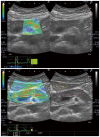Elastography for the pancreas: Current status and future perspective
- PMID: 27076756
- PMCID: PMC4814734
- DOI: 10.3748/wjg.v22.i14.3712
Elastography for the pancreas: Current status and future perspective
Abstract
Elastography for the pancreas can be performed by either ultrasound or endoscopic ultrasound (EUS). There are two types of pancreatic elastographies based on different principles, which are strain elastography and shear wave elastography. The stiffness of tissue is estimated by measuring the grade of strain generated by external pressure in the former, whereas it is estimated by measuring propagation speed of shear wave, the transverse wave, generated by acoustic radiation impulse (ARFI) in the latter. Strain elastography is difficult to perform when the probe, the pancreas and the aorta are not located in line. Accordingly, a fine elastogram can be easily obtained in the pancreatic body but not in the pancreatic head and tail. In contrast, shear wave elastography can be easily performed in the entire pancreas because ARFI can be emitted to wherever desired. However, shear wave elastography cannot be performed by EUS to date. Recently, clinical guidelines for elastography specialized in the pancreas were published from Japanese Society of Medical Ultrasonics. The guidelines show us technical knacks of performing elastography for the pancreas.
Keywords: Elastography; Pancreas; Shear wave; Strain.
Figures










References
-
- Itoh A, Ueno E, Tohno E, Kamma H, Takahashi H, Shiina T, Yamakawa M, Matsumura T. Breast disease: clinical application of US elastography for diagnosis. Radiology. 2006;239:341–350. - PubMed
-
- Lyshchik A, Higashi T, Asato R, Tanaka S, Ito J, Mai JJ, Pellot-Barakat C, Insana MF, Brill AB, Saga T, et al. Thyroid gland tumor diagnosis at US elastography. Radiology. 2005;237:202–211. - PubMed
-
- Sporea I, Bota S, Peck-Radosavljevic M, Sirli R, Tanaka H, Iijima H, Badea R, Lupsor M, Fierbinteanu-Braticevici C, Petrisor A, et al. Acoustic Radiation Force Impulse elastography for fibrosis evaluation in patients with chronic hepatitis C: an international multicenter study. Eur J Radiol. 2012;81:4112–4118. - PubMed
-
- Bota S, Sporea I, Peck-Radosavljevic M, Sirli R, Tanaka H, Iijima H, Saito H, Ebinuma H, Lupsor M, Badea R, et al. The influence of aminotransferase levels on liver stiffness assessed by Acoustic Radiation Force Impulse Elastography: a retrospective multicentre study. Dig Liver Dis. 2013;45:762–768. - PubMed
Publication types
MeSH terms
LinkOut - more resources
Full Text Sources
Other Literature Sources
Medical

